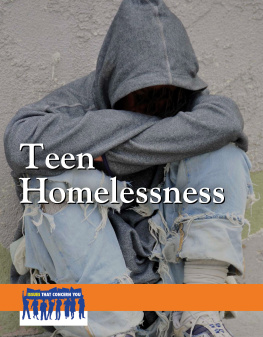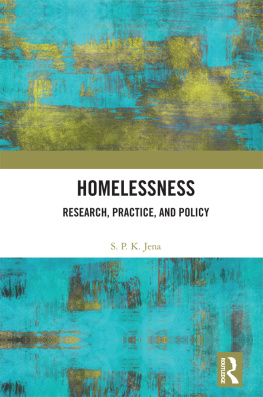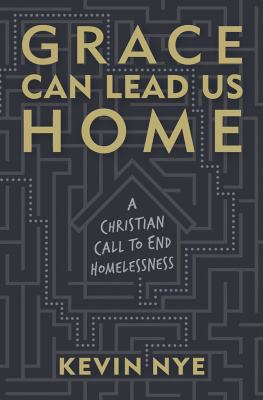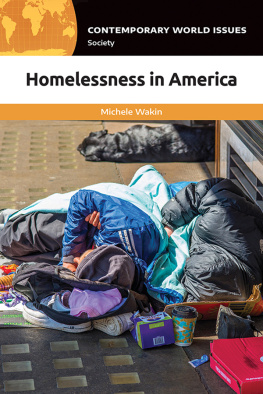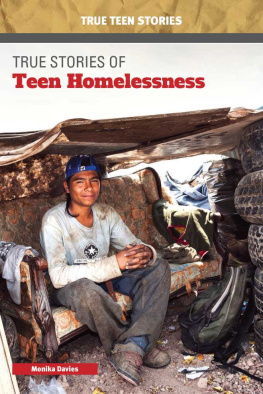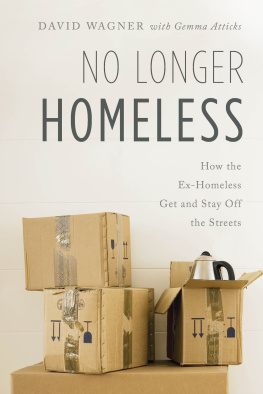Published in 2018 by Greenhaven Publishing, LLC 353 3rd Avenue, Suite 255, New York, NY 10010
Copyright 2018 by Greenhaven Publishing, LLC
First Edition
All rights reserved. No part of this book may be reproduced in any form without permission in writing from the publisher, except by a reviewer.
Articles in Greenhaven Publishing anthologies are often edited for length to meet page requirements. In addition, original titles of these works are changed to clearly present the main thesis and to explicitly indicate the author's opinion. Every effort is made to ensure that Greenhaven Publishing accurately reflects the original intent of the authors. Every effort has been made to trace the owners of the copyrighted material.
Cataloging-in-Publication Data
Names: Erskine, H. Craig, III, editor.
Title: Teen homelessness / edited by H. Craig Erskine III.
Description: New York : Greenhaven Publishing, 2018. | Series: Issues that concern you | Includes bibliographical references and index. | Audience: Grades 9 to 12.
Identifiers: LCCN ISBN 9781534502260 (library bound) |ISBN 9781534502796 (pbk.) Subjects: LCSH: Homeless teenagers--Juvenile literature. | Homelessness--Juvenile literature.
Classification: LCC HV4493.H65528 2018 | DDC 362.7/75692083--dc23 Manufactured in the United States of America
Website: http://greenhavenpublishing.com
CONTENTS
Roya Ijadi-Maghsoodi
Tracy C. Miller
Acton Institute
L. Michael Gipson
Center for American Progress
The International Child and Youth Care Network
Sam P.K. Collins
Jeremy Mark Keierleber
Tori DeAngelis
Colleen Doescher-Train
Child Welfare Information Gateway
Rachel Lippman
Erika Aguilar
Babysteps Ministry
What You Should Know About Teen Homelessness
What You Should Do About Teen Homelessness
T he National Runaway Switchboard estimates that on any given night there are approximately 1.3 million homeless youth living unsupervised on the streets, in abandoned buildings, with friends, or with strangers. Homeless youth are at a higher risk for physical abuse, sexual exploitation, mental health disabilities, substance abuse, and death. It is estimated that 5,000 unaccompanied youth will die each year as a result of assault, illness, or suicide.
Homeless youth are typically defined as unaccompanied young people aged 12 and over who do not have a permanent place to stay and who are living in shelters, on the street, in cars or vans, or vacant buildings, or are couch surfing, or otherwise living in unstable circumstances. The Runaway and Homeless Youth Act (RHYA), administered by the Family and Youth Services Bureau and funded by the Department of Health and Human Services Administration for Children and Families, defines homeless youth as individuals who are not more than 21 years of age...for whom it is not possible to live in a safe environment with a relative and who have no other safe alternative living arrangement.
The US Department of Education defines homeless youth as youth who lack a fixed, regular, and nighttime residence, or an individual who has a primary nighttime residence that is: a) a supervised or publically operated shelter designed to provide temporary living accommodation; b) an institution that provides a temporary residence for individuals intended to be institutionalized including welfare hotels, congregate shelters and transitional housing for the mentally ill; or c) a public or private place not designed for, or ordinarily used as a regular sleeping accommodation for human beings.
Teen homelessness has many faces, from the young member of a family that has been evicted from their home due to substance abuse, or gambling addictions by one or both of the parents, or just from existing in the depths of poverty. The family may be living out of a car or van and roaming between parks and interstate rest areas. To the young teen who has run away - escaping physical, emotional, or even sexual abuse, or other family violence. To the teenager who has finally revealed his or her sexual orientation to their religious, ultra-conservative parents, only to be banished from their presence. To the young girl who leaves home rather than face her parents, or becomes pregnant while she is out on the street. Teen homelessness wears the face of all ages, all orientations, and all ethnicities.
A report, by the Office of Juvenile Justice and Delinquency Prevention, in the US Department of Justice, published in 2002, estimated 1.7 million homeless and runaway youth were equally divided among males and females, with the majority of them between the ages of 15 and 17. According to the US Conference of Mayors, in 2005, unaccompanied youth accounted for 3% of the urban homeless population. The National Network of Runaway and Youth Services states 6 percent of homeless youth are LGBTQ. Ten percent of homeless youth were recorded as pregnant (Greene and Ringwalt, 1998). All of these individuals, collectively, become potential victims of further exploitation, or even human trafficking.
Human trafficking is commonly referred to as a form of modern-day slavery in which people profit from controlling and exploiting others. According to the US Department of Homeland Security, traffickers use force, fraud or coercion to lure their victims and force them into labor or prostitution. The victims then get arrested for a variety of crimes, including soliciting, chronic truancy, possession of drugs, public indecency, and assault. They also face contact with alcohol and many types of drugs, and they risk exposure to STDs and other viral infections with few options for treatment. Some even lose their life.
Homelessness among young people continues to remain a serious social issue today. The consequences of ignorance and silence cannot be ignored. Youth homelessness and its consequences are not just problems for those involved, but for society in general and the cost to society is high. States spend approximately $5.7 billion each year to incarcerate youth for a non-violent offence such as homelessness. Furthermore, the problems and barriers these youth face clearly hinder their ability to become contributing, successful members of their families and society. If they dont receive the help they need while theyre young, they may very well become tomorrows chronically homeless adults.
The issues related to teen homelessness are not without their controversies. For example, the foster care system is meant to take in orphaned and disadvantaged youths and provide for their wellbeing. But in some cases the very organizations set up to help them abuse them and they run away to escape. The situation may lead the vulnerable teen to become a gang member for a sense of belonging.
What is societys responsibility? There are many conflicting views on this topic. Some believe that social welfare encourages dependency. Others believe that social welfare programs help those truly in need. Some believe that communities should build more homeless shelters, while others believe that such shelters encourage complacency, increase crime, and lower surrounding home values.
Teen homelessness does not only affect the young people who find themselves without a stable living situation. Because homeless teens are associated with criminal futures and possible incarceration, lower education levels, psychological and physical health issues, and bleak employment prospects, teen homelessness is a societal problem. If there is debate over whether or not a society is responsible for ensuring the safety and stability of its children, there is no question that society will end up paying the price sooner or later.

